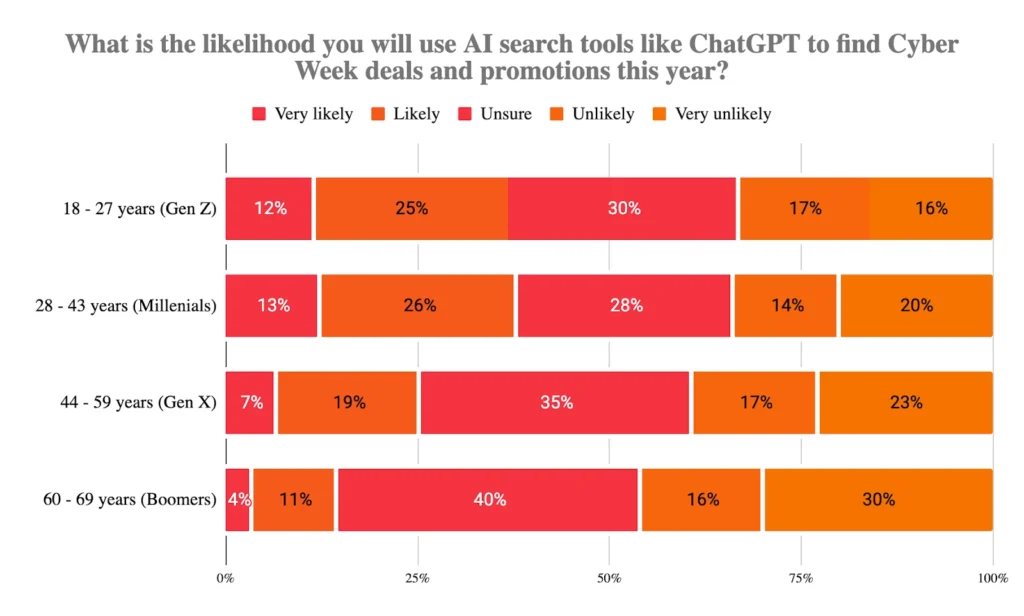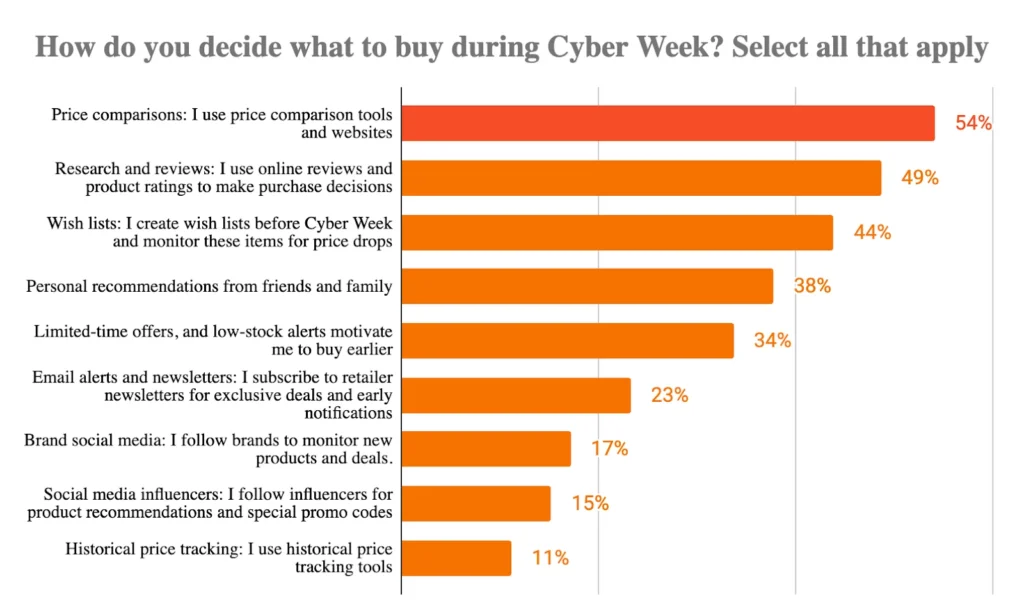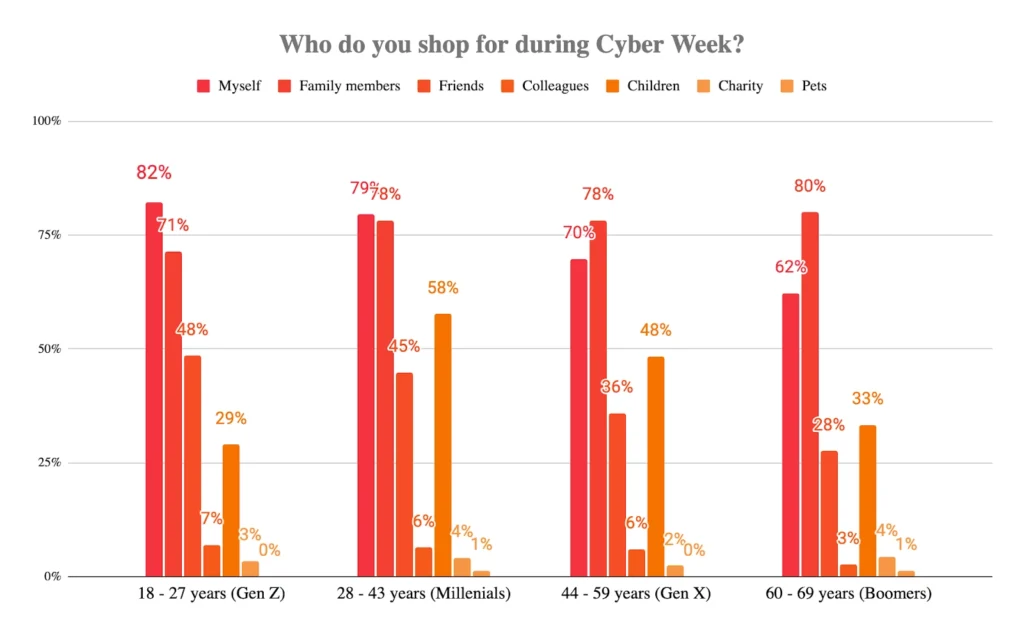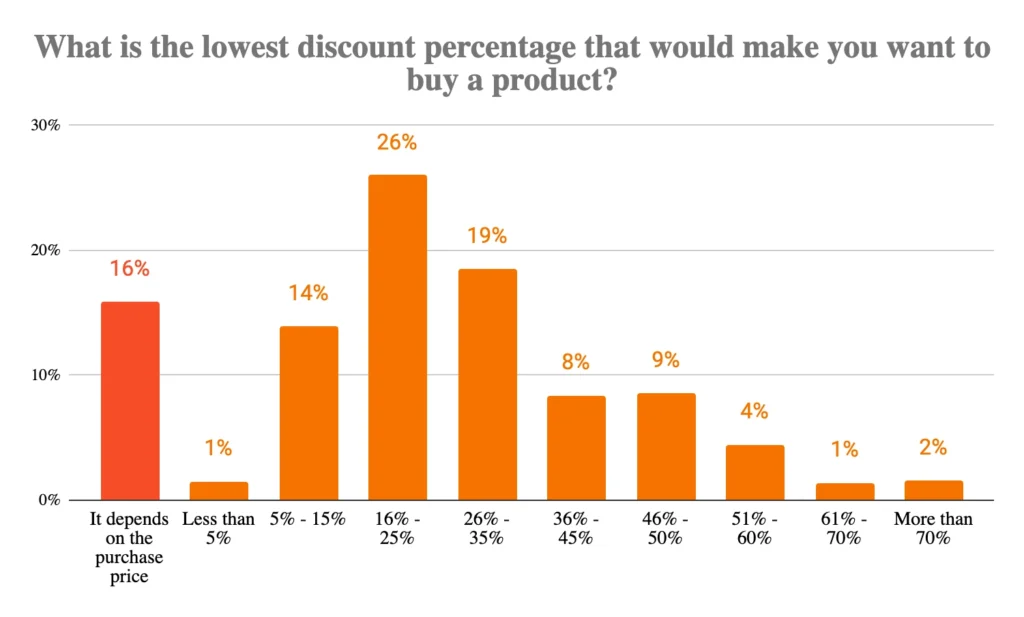In 2023, 200.4 million consumers shopped over Cyber Week, beating last year’s record of 196.7 million and exceeding initial expectations. Brands that tapped into partnership marketing saw revenue increase 13% YoY last year, emphasizing the importance of tailoring the channel’s strategies to evolving customer behavior.
Most consumers plan to spend the same amount or more in-store or online as last year, building wish lists and conducting research weeks in advance to find and track the best deals. This approach positions them to pounce on the best deals.
Creating a successful partnership marketing strategy relies on a deeper understanding of consumer behavior. The latest impact.com Cyber Week 2024 consumer research reveals nine insights your brand should consider to develop a practical marketing approach for the 2024 shopping season.
9 shopper insights to transform your Cyber Week strategy
The impact.com team conducted a consumer behavior research study that polled consumers aged 18 to 69 who shop online—either exclusively or partially—and plan to buy something during Cyber Week this year. The data was collected between July 19 – 29, 2024.
The research data came from more than 1,000 consumers in the United States. Brands can use this information to discover the following:
- Consumer’s in-store or online shopping preference to align sales channels with purchasing habits.
- Deal types capture shoppers’ interest.
- Research methods help consumers make buying decisions.
- Insights into generational shopping differences to tailor marketing strategies accordingly.
As consumers watch inflation and interest rates closely, brands need to understand how consumer buying has changed over the past year and use these insights to build a successful 2024 Cyber Week strategy.
1. Consumers set to splurge: 32% anticipate spending more this year
Excitement is building for Cyber Week 2024 as more shoppers prepare to dive into the deals. Nearly one-fifth (18%) of respondents who intend to shop this year didn’t make any purchases during Cyber Week 2023.

Of those who did shop, 34% plan to spend the same amount as they did in 2023, while nearly a third (32%) intend to spend more money. The majority of Gen Z (40%) and Millennials (37%) plan to spend more than last year, while the majority of Gen X and Boomers intend to spend the same amount as last year.
Turning insights into action: Strategies to consider
Use these strategic tips to engage new and returning shoppers to connect with your audience, capture their attention, and drive sales.
Capitalize on spending intentions: Promote bundle deals and tiered discounts to encourage higher spending.
Leverage generational trends: Attract Gen Z and Millennials with mobile-friendly content and influencer collaborations. Loyalty programs and personalized offers, such as discounts on frequently purchased items or early access to promotions, should be used to maintain the engagement of Gen X and Boomers.

Source: Platforms such as Rewardsweb connect loyalty programs, merchants, and users
Engage new shoppers: Convert first-time buyers with targeted ads and offer introductory discounts or exclusive first-time buyer deals to entice them.
2. Shop in comfort: 29% of shoppers are committed to online-only purchases
A significant 42% of consumers plan to blend online and in-store purchases, showcasing a versatile shopping approach. Meanwhile, 29% are committed to shopping exclusively online, with Boomers leading this trend at 34%.
Interestingly, 23% of shoppers remain undecided, poised to pivot based on appealing deals, emphasizing the importance of strategic deals and offers to capture the attention of this segment.

Generationally, Millennials (49%), Gen Z (44%), and Gen X (42%) particularly favor the combination of in-store and online shopping, reflecting a balanced shopping strategy that capitalizes on the strengths of both channels. Despite the appeal of digital and hybrid shopping experiences, in-store purchases alone remain the least favored option.

Turning insights into action: Strategies to consider
Understanding and syncing your Cyber Week strategy to your audience’s shopping preferences will enhance customer satisfaction, ensure you meet potential customers where they are, and differentiate your brand during this bustling shopping season.
Optimize for omnichannel engagement: Create cohesive experiences that allow customers to transition easily between online and physical stores. For example, implement a loyalty program that rewards points for both online and in-store purchases, or repurpose user-generated content (UGC) across different channels.
Engage online-only shoppers: Connect with consumers by collaborating with partners such as influencers, publishers, and review sites and offering exclusive online-only deals.

Source: Partners with sites such as Giftly that offer private discounts
Capture the undecided: Introduce flash sales and limited-time offers to convert deal-driven consumers.
3. Tap to buy: 56% of consumers shop online via smartphone
More than half (56%) of online shopping occurs on consumer’s smartphones, highlighting the need for seamless experiences from laptop to smartphone.
While Millennials are most likely (70%) to use smartphones to make online purchases, it’s also the number one choice for all the other generations: Gen Z (54%), Gen X (58%), and Boomers (36%). However, Boomers have a close split between shopping online via their laptops (35%) and smartphones (36%).

Turning insights into action: Strategies to consider
Explore these tactics to drive more effective consumer engagement during Cyber Week.
Prioritize mobile optimization: Optimize loading speed and simplify navigation to enhance experience and prevent drop-off.
Seamless cross-device experience: Implement responsive design strategies to provide a consistent look and feel across devices—especially when working with partners.
Leverage mobile-exclusive promotions: Collaborate with affiliates to offer promotions accessible only through mobile devices. For instance, a retail brand could partner with a popular app-based coupon provider to distribute exclusive Cyber Week deals.
Tap into creators with mobile-first strategies: Work with content creators to develop engaging, mobile-optimized content, such as quick tips or mini-reviews.

Source: Creator Tim Dessaint provides men’s fashion inspiration and tips
4. Deal hunting goes digital: 63% of shoppers head to retailer websites
Consumers show a more direct and personalized approach to accessing promotions, reflected by the top three sources they look for deals:
- Retailer websites (63%)
- Retailer mobile apps (39%)
- Email alerts and newsletters (36%)

However, shoppers mentioned that the most helpful sources for discovering Cyber Week deals in the past were word of mouth from family and friends (17%), coupon websites (16%), and review sites (15%). This demonstrates that consumers adopt a varied strategy when seeking out deals.
Different generations are leveraging these platforms in unique ways. Social media personalities increasingly influence Gen Z, checking influencer recommendations alongside retailer websites.
Millennials and Gen X favor the convenience of mobile apps for their offers, complemented by email alerts. Boomers, preferring traditional means, rely heavily on email alerts and newsletters, followed by mobile apps.
Turning insights into action: Strategies to consider
Adapting your strategies ensures your brand is present across these diverse platforms. Discover some techniques to effectively capture the attention of diverse consumer groups during Cyber Week.
Optimize retailer websites: Ensure your website is user-friendly and mobile-responsive. Streamline navigation and enhance search functionalities to make deal discovery effortless. For example, a clear “Cyber Week Deals” section can direct users to promotions.
Enhance mobile app features: Focus on app-exclusive deals and push notifications to keep users engaged. For instance, implementing a gamified deal hunt within the app can increase interactions.
Segment communications: Tailor your communication strategy to address the preferences of each demographic. Strategically use partners to segment your audience and send targeted messages—such as influencers for Millenials and email affiliates for Boomers.

Source: SafeOpt is a prime example of an email partner
Create a multichannel experience: Integrate efforts across websites, apps, and emails to create a seamless shopping experience. For example, a promotion seen on a mobile app can be followed up with an email reminder.
5. Savvy shoppers: 92% conduct research to snag the best deals
Almost all (92%) shoppers engage in research before making purchases, underlining the critical role of preparatory activities in the buyer’s journey.

A notable trend is the timing of this research: 30% of consumers begin as early as October or even sooner. An additional 63% initiate their research in the month leading up to the holiday season. This early start lets consumers strategically plan their purchases, make well-informed decisions, and create wish lists to track and compare price drops during Cyber Week.
Research helps consumers understand how much products should cost and when to make purchases. In fact, most consumers are likely (53%) or very likely (26%) to have a price in mind before making a purchase.
Wish lists are a widespread research tactic used by nearly half of the consumers (49%). Shoppers use them to track desired items and get alerts on price drops, ensuring they capitalize on the best deals available. Additionally, 38% use retailer newsletters and alerts as a key deal-hunting tool.

Gen Z shoppers follow brands on social media—43% leverage these platforms for teasers, early bird specials, and exclusive promo codes, showcasing their digital-savvy nature. They also lead in using price-tracking tools, which help them make cost-effective choices.
Gen X and Boomers prefer traditional channels, with 44% and 47% subscribing to retailer newsletters and alerts, respectively. They value direct communication about upcoming deals.

Turning insights into action: Strategies to consider
Navigate your audience’s diverse research habits and preferences with these effective strategies.
Initiate early promotions: To create buzz ahead of the shopping season, offer sneak peeks and early bird deals. For instance, showcase exclusive previews and discounts on deal and coupon sites.

Source: Deals site, Slickdeals drives product discovery by hosting community-vetted deals
Engage Gen Z via social media: Use Instagram and TikTok to create dynamic content that resonates with this digital-savvy audience. Collaborate with influencers like The Bargain Sisters to release teasers, early bird specials, and exclusive promo codes.
Utilize price-tracking partnerships: Partner with price-tracking apps to provide consumers with transparent and competitive pricing information — appealing to cost-conscious shoppers.
6. Trust for AI is growing: 30% plan to use AI search tools
As excitement around AI drives the stock market, consumers are mixed on whether AI search tools are the way to find Cyber Week deals and promotions.
Around 30% of shoppers will likely use AI search tools to uncover promotions, reflecting a shift toward more tech-driven shopping experiences. However, 38% are unlikely to incorporate AI in their research process, possibly due to concerns about trust and familiarity with the technology.

Gen Z (37%) and Millennials (38%) are likelier than any other age group to use AI for deal hunting. Their comfort with technology and desire for a streamlined shopping process may explain their enthusiasm. These generations are accustomed to digital solutions that enhance convenience and personalization.

As AI continues to evolve—becoming more intuitive and secure—its adoption may increase across all age groups.
Turning insights into action: Strategies to consider
Brands should focus on integrating AI-driven tools and strategies into their marketing plans to effectively capture the growing segment of consumers inclined to use AI during Cyber Week.
Leverage AI-powered search tools: Implement AI-driven search functionalities on your website to enhance user experience. These tools can offer personalized product recommendations based on browsing history and past purchases, making it easier for consumers to find what they want.
Personalized promotions with AI: Use AI algorithms to analyze consumer data and create tailored promotions. These can include dynamic discounts or personalized deal notifications that cater to individual shopping habits and preferences.
AI-enhanced customer support: During Cyber Week, deploy AI chatbots to provide real-time customer support and answer queries. This can streamline the shopping experience and resolve issues quickly, improving customer satisfaction.
7. Informed shopping: Comparison tools, reviews, and wish lists steer purchase decisions
A notable 54% of shoppers use price comparison tools to find the best deals, underscoring the need for transparent and competitive pricing.

Online reviews and ratings influence 49% of consumers. Further insights show that consumers favor written reviews (43%), followed by customer testimonials (22%). Gen Z shows a balanced interest in written and video reviews, while customer testimonials remain a favorite with Boomers.


Wish lists are crucial in the research and decision-making process, with 44% of consumers tracking them for price drops. Interestingly, 60% of wish list users generally adhere to their lists but may indulge in additional purchases if they find a good deal.
Additionally, more than a third of consumers often add items outside their wish list. This presents retailers with the opportunity to use dynamic pricing and personalized promotions to boost sales.

Turning insights into action: Strategies to consider
Understanding these patterns allows brands to tailor approaches to enhance engagement and conversion rates.
Emphasize transparent and competitive pricing: Ensure your pricing is clear and competitive. Synchronize promotions and spotlight exclusive deals with partners to make your offers stand out.
Enhance online reputation: Encourage satisfied customers to leave written reviews to influence customer decisions. Additionally, feature in blogger listicles, promote user-generated content (UGC) on product pages and ask influencers to create authentic product reviews.

Source: Creator, Dhee, provide mommy-approved product reviews.
Optimize wish lists and employ dynamic pricing: Trigger alerts for wish list items that receive a price drop and offer exclusive time-sensitive discounts on related products.
Suggest complementary items: With consumers willing to add items outside their wish list, use smart recommendations to encourage customers to make additional purchases. Display related items during checkout, enticing consumers to add more to their cart.
8. Gift or treat: 77% of consumers shop for gifts, while 74% indulge
Many consumers use Cyber Week to shop for gifts (77%) and themselves (74%). This dual-purpose shopping suggests this shopping season is not just about gifting but also about personal indulgence, making it essential for brands to balance promotions that appeal to both motivations.

Consumer preferences are becoming increasingly clear, with specific product categories dominating shopping lists.
- Electronics (65%) lead the charge as consumers prioritize tech upgrades and connectivity.
- Fashion and apparel (62%) reflect the ongoing demand for style and personal expression.
- Toys and games (51%) remain a favorite for those shopping for children.
- Beauty and personal care (40%) gain traction with a focus on self-care and wellness.
- Home goods and furniture (36%) suggest consumers invest in their living spaces.

Gen Z primarily shop for themselves (82%), mirroring the shopping behavior observed in Millennials (79%). These age groups’ greater disposable income and personal preferences could influence this. In contrast, Gen X and Boomer shoppers prefer purchasing for family members, highlighting their focus on gifting during Cyber Week.
Interestingly, while Cyber Week is often seen as adult-centric, many Millennials (58%) and Gen X (48%) are shopping for their children. Even among Boomers (33%) and Gen Z (29%), there’s a notable intention to buy for children. This trend emphasizes the period’s family-oriented spirit, and retailers can promote family-friendly products and deals.

Turning insights into action: Strategies to consider
Use the following suggestions to align your strategy with consumers’ shopping intentions.
Feature in gift guides: Get affiliate publishers to place your products in gift guides, such as All Gifts Considered. Point out products that offer personal enjoyment and gift potential.
Encourage influencers to curate personal picks: Engage influencers to create content that tells compelling stories, blending personal indulgence with gifting.

Source: Influencer Robert Welsh uses social media to share his make-up favorites
Craft cross-category bundles: Generate unique offers by creating co-branding campaigns that merge popular shopping categories. For instance, a beauty brand collaborates with a fashion designer to create exclusive kits, including signature beauty products and accessories.
9. Close the deal: promos and discounts drive sales
The availability of deals and discounts emerges as the most influential factor driving purchase decisions, with 88% of consumers rating it as very or extremely important. This preference is even more pronounced among Boomers, with an overwhelming 97% prioritizing discounts.
Following closely, free delivery and stock availability are critical, with 79% of consumers confirming their importance. These insights highlight how financial incentives and convenience significantly shape consumer behavior.

Among the leading deals and promotions that attract shoppers are free shipping (59%), buy one, get one free offer (51%), and percentage discounts (46%). These deals are favored for their immediate value, simplifying the decision-making process for price-sensitive consumers.

The impact of percentage discounts on consumer behavior is particularly noteworthy. While 16% of shoppers express that their motivation is contingent upon the product’s original price, 26% indicate that a 16-25% discount is sufficient to encourage a purchase.

Reflecting on last year’s trends, one in four consumers cited that a discount of 26% to 35% was the minimum they required to commit to a purchase. This suggests a shift in consumer expectations towards being more receptive to slightly lower discount rates.
Turning insights into action: Strategies to consider
Engage consumers, drive high transaction values, and the impact of Cyber Week promotions with the following recommendations.
Implement tiered discounts: Encourage higher spending by offering escalating discounts based on purchase amounts. For example, offer a 10% discount on purchases up to $50, a 20% discount for $51-$100, and a 30% discount for over $100. Collaborate with deals and coupon sites to promote these tiered savings, ensuring broad visibility and attracting budget-conscious shoppers.
Create bundled offers: Product bundles offer an excellent opportunity to increase transaction values by pairing frequently purchased items or complementary goods at a discounted rate. By leveraging content publishers to promote these bundles in themed articles, businesses can effectively showcase the value and convenience that these offers provide.
Fine-tune your Cyber Week game plan to give your brand a competitive edge
Understanding consumer behaviors for Cyber Week 2024 provides a unique opportunity for brands to tailor their strategies effectively. By tapping into these insights, brands can better meet shopper expectations and capitalize on spending trends. The key is to approach these insights with creativity and precision, ensuring that strategies are reactive and proactive in addressing consumer needs.
Partnership marketing stands out as a powerful way to gain a strategic advantage. By collaborating with partners who resonate with target audiences, brands can extend their reach and enhance their offerings. These alliances offer a way to connect authentically with consumers, driving engagement and loyalty. Embrace these insights and partnerships to craft strategies that position your brand for success, not just during Cyber Week but well into the future.
Check out these resources for more Cyber Week insights:
- 6 insights for publishers to maximize commerce content income this Cyber Week [blog]
- Cyber Week Research 2023: Biggest Consumer Behavior Trends [blog]
- Cyber Week 2023: Research Study Reveals Key Trends [blog]
- Navigate 2024 with these 5 insightful consumer shopping trends [blog]
- Cyber Week cheat codes: Level up with key consumer insights [Infographic]





